Related Research Articles
In electrical engineering, the power factor of an AC electrical power system is defined as the ratio of the real power absorbed by the load to the apparent power flowing in the circuit, and is a dimensionless number in the closed interval of −1 to 1. A power factor of less than one indicates the voltage and current are not in phase, reducing the average product of the two. Real power is the instantaneous product of voltage and current and represents the capacity of the electricity for performing work. Apparent power is the product of RMS current and voltage. Due to energy stored in the load and returned to the source, or due to a non-linear load that distorts the wave shape of the current drawn from the source, the apparent power may be greater than the real power. A negative power factor occurs when the device generates power, which then flows back towards the source.

In electricity generation, a generator is a device that converts motive power into electrical power for use in an external circuit. Sources of mechanical energy include steam turbines, gas turbines, water turbines, internal combustion engines, wind turbines and even hand cranks. The first electromagnetic generator, the Faraday disk, was invented in 1831 by British scientist Michael Faraday. Generators provide nearly all of the power for electric power grids.

A substation is a part of an electrical generation, transmission, and distribution system. Substations transform voltage from high to low, or the reverse, or perform any of several other important functions. Between the generating station and consumer, electric power may flow through several substations at different voltage levels. A substation may include transformers to change voltage levels between high transmission voltages and lower distribution voltages, or at the interconnection of two different transmission voltages.

A current transformer (CT) is a type of transformer that is used to reduce or multiply an alternating current (AC). It produces a current in its secondary which is proportional to the current in its primary.
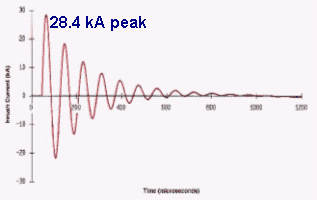
Inrush current, input surge current, or switch-on surge is the maximal instantaneous input current drawn by an electrical device when first turned on. Alternating-current electric motors and transformers may draw several times their normal full-load current when first energized, for a few cycles of the input waveform. Power converters also often have inrush currents much higher than their steady-state currents, due to the charging current of the input capacitance. The selection of over-current-protection devices such as fuses and circuit breakers is made more complicated when high inrush currents must be tolerated. The over-current protection must react quickly to overload or short-circuit faults but must not interrupt the circuit when the inrush current flows.

A frequency changer or frequency converter is an electronic or electromechanical device that converts alternating current (AC) of one frequency to alternating current of another frequency. The device may also change the voltage, but if it does, that is incidental to its principal purpose, since voltage conversion of alternating current is much easier to achieve than frequency conversion.
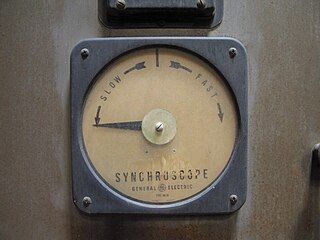
In AC electrical power systems, a synchroscope is a device that indicates the degree to which two systems are synchronized with each other.
Islanding is the condition in which a distributed generator (DG) continues to power a location even though electrical grid power is no longer present. Islanding can be dangerous to utility workers, who may not realize that a circuit is still powered, and it may prevent automatic re-connection of devices. Additionally, without strict frequency control the balance between load and generation in the islanded circuit is going to be violated, leading to abnormal frequencies and voltages. For those reasons, distributed generators must detect islanding and immediately disconnect from the circuit; this is referred to as anti-islanding.
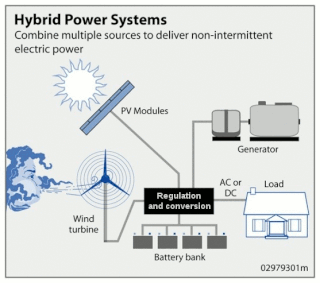
A stand-alone power system, also known as remote area power supply (RAPS), is an off-the-grid electricity system for locations that are not fitted with an electricity distribution system. Typical SAPS include one or more methods of electricity generation, energy storage, and regulation.
Doubly-fed electric machines also slip-ring generators are electric motors or electric generators, where both the field magnet windings and armature windings are separately connected to equipment outside the machine.
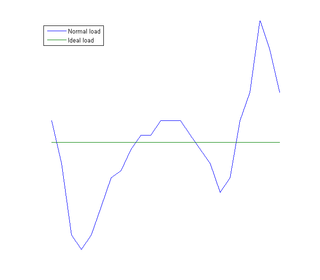
Load management, also known as demand-side management (DSM), is the process of balancing the supply of electricity on the network with the electrical load by adjusting or controlling the load rather than the power station output. This can be achieved by direct intervention of the utility in real time, by the use of frequency sensitive relays triggering the circuit breakers, by time clocks, or by using special tariffs to influence consumer behavior. Load management allows utilities to reduce demand for electricity during peak usage times, which can, in turn, reduce costs by eliminating the need for peaking power plants. In addition, some peaking power plants can take more than an hour to bring on-line which makes load management even more critical should a plant go off-line unexpectedly for example. Load management can also help reduce harmful emissions, since peaking plants or backup generators are often dirtier and less efficient than base load power plants. New load-management technologies are constantly under development — both by private industry and public entities.

An electric power system is a network of electrical components deployed to supply, transfer, and use electric power. An example of an electric power system is the grid that provides power to an extended area. An electrical grid power system can be broadly divided into the generators that supply the power, the transmission system that carries the power from the generating centres to the load centres, and the distribution system that feeds the power to nearby homes and industries. Smaller power systems are also found in industry, hospitals, commercial buildings and homes. The majority of these systems rely upon three-phase AC power—the standard for large-scale power transmission and distribution across the modern world. Specialised power systems that do not always rely upon three-phase AC power are found in aircraft, electric rail systems, ocean liners and automobiles.
Dynamic voltage restoration (DVR) is a method of overcoming voltage sags and swells that occur in electrical power distribution. These are a problem because spikes consume power and sags reduce efficiency of some devices. DVR saves energy through voltage injections that can affect the phase and wave-shape of the power being supplied.
A grid code is a technical specification which defines the parameters a facility connected to a public electric grid has to meet to ensure safe, secure and economic proper functioning of the electric system. The facility can be an electricity generating plant, a consumer, or another network. The grid code is specified by an authority responsible for the system integrity and network operation. Its elaboration usually implicates network operators, representatives of users and, to an extent varying between countries, the regulating body.
A voltage sag or voltage dip is a short duration reduction in rms voltage which can be caused by a short circuit, overload or starting of electric motors. A voltage sag happens when the rms voltage decreases between 10 and 90 percent of nominal voltage for one-half cycle to one minute. Some references defines the duration of a sag for a period of 0.5 cycle to a few seconds, and longer duration of low voltage would be called a "sustained sag".
Wide-area damping control (WADC) is a class of automatic control systems used to provide stability augmentation to modern electrical power systems known as smart grids. Actuation for the controller is provided via modulation of capable active or reactive power devices throughout the grid. Such actuators are most commonly previously-existing power system devices, such as high-voltage DC (HVDC) transmission lines and static VAR compensators (SVCs) which serve primary purposes not directly related to the WADC application. However, damping may be achieved with the utilization of other devices installed with the express purpose of stability augmentation, including energy storage technologies. Wide-area instability of a large electrical grid unequipped with a WADC is the result of the loss of generator rotor synchronicity and is typically envisioned as a generator oscillating with an undamped exponential trajectory as the result of insufficient damping torque.

Electrical Transient Analyzer Program (ETAP) is an electrical network modeling and simulation software tool used by power systems engineers to create an "electrical digital twin" and analyze electrical power system dynamics, transients and protection.
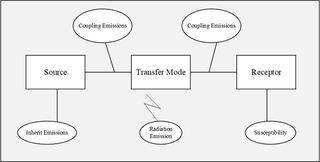
Conducted emissions are the effects in power quality that occur via electrical and magnetic coupling, electronic switch of semiconductor devices which form a part of electromagnetic compatibility issues in electrical engineering. These affect the ability of all interconnected system devices in the electromagnetic environment, by restricting or limiting their intentional generation, propagation and reception of electromagnetic energy.
References
- ↑ IEC Glossary: UVRT
- ↑ http://www.powerqualityworld.com/2011/04/cbema-curve-power-quality-standard.html CBEMA Curve – The Power Acceptability Curve for Computer Business Equipment, 2011-04-03
- ↑ Guo, Wenyong; Xiao, Liye; Dai, Shaotao; Xu, Xi; Li, Yuanhe; Wang, Yifei (2019-06-18). "Evaluation of the Performance of BTFCLs for Enhancing LVRT Capability of DFIG". IEEE Transactions on Power Electronics. 30 (7): 3623–3637. doi:10.1109/TPEL.2014.2340852.
- ↑ Mahrouch, Assia; Ouassaid, Mohammed; Elyaalaoui, Kamal (2019-06-18). "LVRT Control for Wind Farm Based on Permanent Magnet Synchronous Generator Connected into the Grid". 2017 International Renewable and Sustainable Energy Conference (IRSEC). pp. 1–6. doi:10.1109/IRSEC.2017.8477281. ISBN 978-1-5386-2847-8.
- ↑ Liasi, Sahand Ghaseminejad; Afshar, Zakaria; Harandi, Mahdi Jafari; Kojori, Shokrollah Shokri (2018-12-18). "An Improved Control Strategy for DVR in order to Achieve both LVRT and HVRT in DFIG Wind Turbine". 2018 International Conference and Exposition on Electrical and Power Engineering (EPE). pp. 0724–0730. doi:10.1109/ICEPE.2018.8559605. ISBN 978-1-5386-5062-2.
- ↑ Harandi, Mahdi Jafari; Ghaseminejad Liasi, Sahand; Nikravesh, Esmail; Bina, Mohammad Tavakoli (2019-06-18). "An Improved Control Strategy for DFIG Low Voltage Ride-Through Using Optimal Demagnetizing method". 2019 10th International Power Electronics, Drive Systems and Technologies Conference (PEDSTC). pp. 464–469. doi:10.1109/PEDSTC.2019.8697267. ISBN 978-1-5386-9254-7.
- ↑ Akagi, H.; Edson Hirokazu Watanabe; Mauricio Aredes (2007). Instantaneous power theory and applications to power conditioning. IEEE Press Series of Power Engineering. John Wiley & Sons. p. 137. ISBN 978-0-470-10761-4.
- ↑ BDEW Medium Voltage Guideline Archived 2012-11-05 at the Wayback Machine retrieved on 9 November 2008
- ↑ BDEW MV Guideline 2nd Supplement retrieved in 07/2010
- ↑ BDEW MV Guideline 3rd Supplement Archived 2013-01-27 at the Wayback Machine retrieved in 02/2011
- ↑ BDEW MV Guideline 4th Supplement Archived 2013-08-16 at the Wayback Machine retrieved in 12/2015
- ↑ National Grid Code Archived 2010-02-14 at the Wayback Machine retrieved on 9 2008-11-9
- ↑ IEC 61000-4-11
- ↑ "IEC 61000-4-34:2005 - electromagnetic compatibility, EMC, smart city". IEC Webstore. 2005-10-17. Retrieved 2019-07-04.